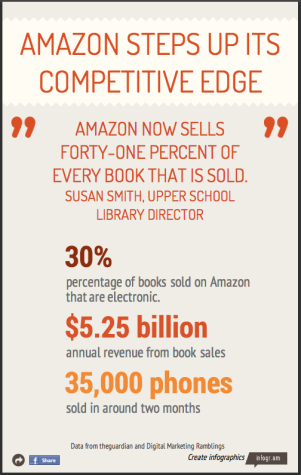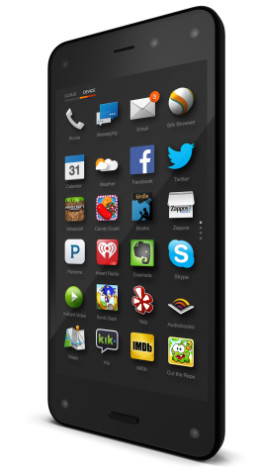Amazon Steps Up Its Competitive Edge
Amazon-Hachette eBook relations deadlock
Amazon has made a controversial decision to reduce e-book prices, which has received scrutiny from many authors and publishers who claim the action has hurt independent creators financially.
The argument, according to CNET and a statement from the Amazon Books Team, arose because Amazon wishes to reduce the price consumers pay for e-books, while publishing companies, including Hachette, are averse to this move.
Noteworthy author Douglas Preston, who collaborates with Hachette, does not agree with Amazon’s perspective on the argument.
“Amazon has been misrepresenting our views, claiming that we’re for higher book prices,” Preston said. “Amazon is actually trying to make its book business profitable, which it apparently is not at the present time, by asking for a larger share of Hachette’s revenue. The ‘we are fighting for lower ebook prices’ is an Amazon public relations strategy.”
Preston added that he is “in favor of affordable books and a healthy publishing ecosystem in which Amazon makes a profit, the publisher makes a profit, and authors can make a living from writing books.”
Echoing the author’s thoughts on the matter, some students support Hachette and believe that authors should have the right to set their own prices for the books they sell.
“I believe that all transactions that take place on Amazon are the result of consent between the buyer and seller,” Rahul Balakrishnan (12) said. “Therefore, sellers have as much right to set prices as buyers have to buy items. People, corporations, and publishers should all be allowed to set their own prices on the website.”
Rahul believes that Amazon should make sure it has the consent of its publishers before it does anything to alter the electronic book market.
Amazon was one of the first companies to enter the e-book market with the introduction of its Kindle e-reader in 2007. One of the more popular e-readers on the market, the Kindle family has led the industry and has now expanded to include the e-ink Kindle Paperwhite and the Kindle Fire color tablet. Other competitors in the e-reader market include Barnes & Noble, Apple, Sony, and Kobo.
Susan Smith, the Library Director at the Upper School, believes that these technology companies are ultimately in charge of what is going to happen.
“It’s all about Apple and Amazon. They are going to control the outcome with their powerful legal teams and so forth,” Smith said. “Amazon now sells forty-one percent of every book that is sold. Forty-one percent. That’s a huge, huge player…You’d be silly to think that the publishers are going to call the shots on this. It’s going to be determined by Apple and Amazon.”
In terms of public libraries, Smith reinforced that these institutions serve the public, although publishers are making this responsibility tougher.
“From a library standpoint…we feel like it’s our duty to bring free books to people any way they want them. Public libraries in the course of gazillion decades in this country have always been able to collect and offer free books to people. We want to continue to do that,” Smith said. “The democratic idea of free public libraries is that people can read for free…Libraries are just getting killed with the [publishing company Overdrive’s] subscription prices, which are quite high.”
Since the inception of the Kindle and other competing devices, e-readers have changed the electronics industry, increased the accessibility of books, and made reading easier. Competitors such as Barnes & Noble and Kobo, which also have their own content stores, have stayed out of the e-book pricing argument thus far.
Like many other authors and consumers, Preston does not know when or how the argument will close.
“I have no idea where this battle will end,” Preston said. “All we are asking is for Amazon to stop sanctioning books as a negotiating strategy.”

Fire phone brings the heat
Amazon raised the stakes considerably in its attempts to corner the e-commerce market with the introduction of the Fire phone and the accompanying release of Fire OS 3.5 operating system on July 25. The new releases are designed to steer consumers to products that can make purchasing directly from the e-commerce giant easier.
Hoping to make waves in the smartphone market, Amazon has included innovative features with the Fire phone, strengthening the relationship between its mobile and commerce division.
Like other popular smartphones, the Fire phone has extensive video and photo capabilities, with the additional bonus that every picture taken is automatically saved to the cloud free of charge. Four cameras, two on each side, make the system versatile and allow for crisp images in a variety of lighting conditions. The extra cameras also track head and eye movements and adjust the screen accordingly, creating a 3D screen effect.

Amazon has promoted the product by granting customers access to Amazon Prime services for a year, which includes the ability to stream music and movies, and free two-day shipping, normally a $99 value.
Fire is built with the latest in hardware technology, with a 4.7 inch HD display, 2048 MB of RAM, and a Quad core processor. For comparison, the iPhone 5S from Apple has a 4.0 inch display, 1024 MB of RAM, and a Dual core processor.
Another notable feature of the Fire phone is the Mayday customer service button, which connects users to a live Amazon representative.
Amazon’s latest feature, Firefly, is a key component of the phone that is able to accurately identify a variety of objects, including songs, T.V. shows, phone numbers, email addresses, and over 70 million household items and consumer products. By simply pointing the phone at a product, Firefly will automatically retrieve related information and show Amazon product details for streamlined shopping.
Although the phone’s operating system is based on Android, the app store is not connected directly to Google Play, which means that users switching to the Fire from other Android phones will have to find substitutes for their favorite apps. For instance, Gmail, Youtube, Google Maps, and Google Drive are not available on Fire’s App Store.
The Fire phone is currently priced at $199 for the 32GB version and $299 for the 64GB version with a two-year contract. Without the contract, the phone costs $650. The phone is currently being sold with an AT&T plan on the Amazon website.
This piece was originally published in the pages of the Winged Post on August 29, 2014.

Vineet Kosaraju (12) is the STEM Editor for both Harker Aquila and Winged Post. He is a senior and has been part of the journalism program for the past...

Vedant Thyagaraj is the Science & Technology Editor for Harker Aquila. He is currently a senior and has been on staff for the past three years. Vedant...

Stanley Zhao (12) is the business manager of the Winged Post. He is a senior this year. Stanley is part of the math club and is currently conducting a...


















![“[Building nerf blasters] became this outlet of creativity for me that hasn't been matched by anything else. The process [of] making a build complete to your desire is such a painstakingly difficult process, but I've had to learn from [the skills needed from] soldering to proper painting. There's so many different options for everything, if you think about it, it exists. The best part is [that] if it doesn't exist, you can build it yourself," Ishaan Parate said.](https://harkeraquila.com/wp-content/uploads/2022/08/DSC_8149-900x604.jpg)




![“When I came into high school, I was ready to be a follower. But DECA was a game changer for me. It helped me overcome my fear of public speaking, and it's played such a major role in who I've become today. To be able to successfully lead a chapter of 150 students, an officer team and be one of the upperclassmen I once really admired is something I'm [really] proud of,” Anvitha Tummala ('21) said.](https://harkeraquila.com/wp-content/uploads/2021/07/Screen-Shot-2021-07-25-at-9.50.05-AM-900x594.png)







![“I think getting up in the morning and having a sense of purpose [is exciting]. I think without a certain amount of drive, life is kind of obsolete and mundane, and I think having that every single day is what makes each day unique and kind of makes life exciting,” Neymika Jain (12) said.](https://harkeraquila.com/wp-content/uploads/2017/06/Screen-Shot-2017-06-03-at-4.54.16-PM.png)








![“My slogan is ‘slow feet, don’t eat, and I’m hungry.’ You need to run fast to get where you are–you aren't going to get those championships if you aren't fast,” Angel Cervantes (12) said. “I want to do well in school on my tests and in track and win championships for my team. I live by that, [and] I can do that anywhere: in the classroom or on the field.”](https://harkeraquila.com/wp-content/uploads/2018/06/DSC5146-900x601.jpg)
![“[Volleyball has] taught me how to fall correctly, and another thing it taught is that you don’t have to be the best at something to be good at it. If you just hit the ball in a smart way, then it still scores points and you’re good at it. You could be a background player and still make a much bigger impact on the team than you would think,” Anya Gert (’20) said.](https://harkeraquila.com/wp-content/uploads/2020/06/AnnaGert_JinTuan_HoHPhotoEdited-600x900.jpeg)

![“I'm not nearly there yet, but [my confidence has] definitely been getting better since I was pretty shy and timid coming into Harker my freshman year. I know that there's a lot of people that are really confident in what they do, and I really admire them. Everyone's so driven and that has really pushed me to kind of try to find my own place in high school and be more confident,” Alyssa Huang (’20) said.](https://harkeraquila.com/wp-content/uploads/2020/06/AlyssaHuang_EmilyChen_HoHPhoto-900x749.jpeg)


